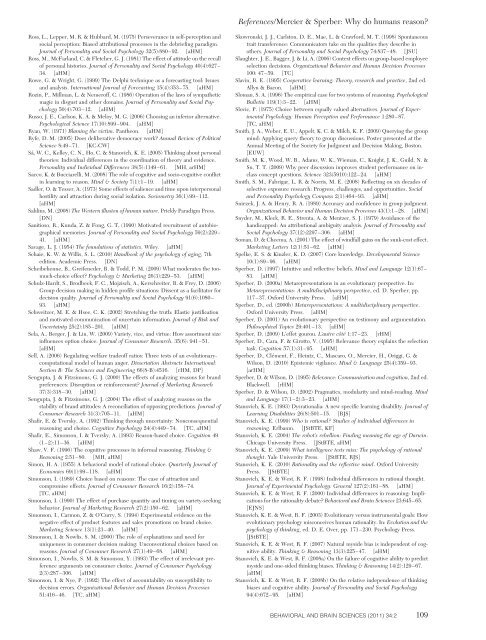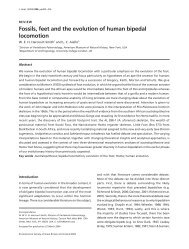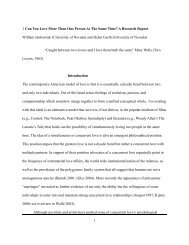References/Mercier & Sperber: <strong>Why</strong> <strong>do</strong> <strong>hum<strong>an</strong>s</strong> <strong>reason</strong>?Newell, A. & Simon, H. A. (1956) The logic <strong>theory</strong> machine: A complex in<strong>for</strong>mationprocessing system. IRE Tr<strong>an</strong>sactions on In<strong>for</strong>mation Theory IT-2(3):61–79.[JW]Newell, B. R., Wong, K. Y., Cheung, J. C. H. & Rakow, T. (2009) Think, blink orsleep on it? The impact of modes of thought on complex decision making.Quarterly Journal of Experimental Psychology 62(4):707–32. [aHM]Newstead, S. E., H<strong>an</strong>dley, S. J. & Buck, E. (1999) Falsifying mental models: Testingthe predictions of theories of syllogistic <strong>reason</strong>ing. Memory & Cognition27(2):344–54. [aHM]Nickerson, R. S. (1998) Confirmation bias: A ubiquitous phenomena in m<strong>an</strong>yguises. Review of General Psychology 2(2):175–220. [aHM, EJNS]Niv, Y. & Schoenbaum, G. (2008) Dialogues on prediction errors. Trends in CognitiveSciences 12(7):265–72. [aHM]Norenzay<strong>an</strong>, A., Smith, E. E., Kim, B. J. & Nisbett, R. E. (2002) Cultural preferences<strong>for</strong> <strong>for</strong>mal versus intuitive <strong>reason</strong>ing. Cognitive Science 26(5):653–84.[rHM]Novaes, C. D. (2005) Medieval obligationes as logical games of consistency mainten<strong>an</strong>ce.Synthese 145(3):371–95. [aHM]Nussbaum, E. M. (2008) Collaborative discourse, argumentation, <strong>an</strong>d learning:Preface <strong>an</strong>d literature review. Contemporary Educational Psychology33(3):345–59. [aHM]Nussbaum, E. M. & Sinatra, G. M. (2003) Argument <strong>an</strong>d conceptual engagement.Contemporary Educational Psychology 28(3):384–95. [aHM]O’Keefe, J. & Dostrovsky, J. (1971) The hippocampus as a spatial map: Preliminaryevidence from unit activity in the freely-moving rat. Brain Research 34(1):171–75. [JW]O’Keefe, J. & Nadel, L. (1978) The hippocampus as a cognitive map. Ox<strong>for</strong>d UniversityPress. [JW]Oaks<strong>for</strong>d, M. & Chater, N. (2007) Bayesi<strong>an</strong> rationality: The probabilistic approachto hum<strong>an</strong> <strong>reason</strong>ing. Ox<strong>for</strong>d University Press. [aHM, MO]Oaks<strong>for</strong>d, M. & Chater, N. (2009) The uncertain <strong>reason</strong>er: Bayes, logic, <strong>an</strong>drationality. Behavioral <strong>an</strong>d Brain Sciences 32:105–20. [JF]Oaks<strong>for</strong>d, M., Chater, N. & Grainger, R. (1999) Probabilistic effects in data selection.Thinking & Reasoning 5(3):193–243. [aHM]Oaks<strong>for</strong>d, M., Chater, N. & Larkin, J. (2000) Probabilities <strong>an</strong>d polarity biases inconditional inference. Journal of Experimental Psychology: Learning, Memory<strong>an</strong>d Cognition 26:883–99. [MO]Oaks<strong>for</strong>d, M. & Hahn, U. (2004) A Bayesi<strong>an</strong> approach to the argument fromignor<strong>an</strong>ce. C<strong>an</strong>adi<strong>an</strong> Journal of Experimental Psychology 58(2):75–85.[aHM]Oaks<strong>for</strong>d, M. & Hahn, U. (2007) Induction, deduction <strong>an</strong>d argument strength inhum<strong>an</strong> <strong>reason</strong>ing <strong>an</strong>d argumentation. In Inductive <strong>reason</strong>ing, ed. A. Feeney &E. Heit, pp. 269–301. Cambridge University Press. [MO]Okada, E. M. (2005) Justification effects on consumer choice of he<strong>do</strong>nic <strong>an</strong>d utilitari<strong>an</strong>goods. Journal of Marketing Research 42(1):43–53. [aHM]Okada, T. & Simon, H. A. (1997) Collaboration discovery in a scientific <strong>do</strong>main.Cognitive Science 21(2):109–46. [aHM]OpenClinical. (2001–2006) PRO<strong>for</strong>ma: Formal knowledge representation method<strong>for</strong> the development <strong>an</strong>d execution of clinical guidelines. Available at: http://www.openclinical.org/gmm_pro<strong>for</strong>ma.html. [JF]Ormerod, P. (2005) <strong>Why</strong> most things fail: Evolution, extinction <strong>an</strong>d economics.Faber & Faber. [aHM]Paese, P. W., Bieser, M. & Tubbs, M. E. (1993) Framing effects <strong>an</strong>d choice shifts ingroup decision making. Org<strong>an</strong>izational Behavior <strong>an</strong>d Hum<strong>an</strong> Decision Processes56(1):149–56. [aHM]Peirce, C. S. (1931–35) Collected papers of Charles S<strong>an</strong>ders Peirce. Harvard UniversityPress. [JW]Pennington, N. & Hastie, R. (1993) Reasoning in expl<strong>an</strong>ation-based decisionmaking.Cognition 49(1–2):123–63. [aHM]Perelm<strong>an</strong>, C. & Olbrechts-Tyteca, L. (1969) The new rhetoric: A treatise on argumentation.University of Notre Dame Press. [aHM, MO]Perkins, D. N. (1985) Postprimary education has little impact on in<strong>for</strong>mal <strong>reason</strong>ing.Journal of Educational Psychology 77(5):562–71. [aHM]Perkins, D. N., Allen, R. & Hafner, J. (1983) Difficulties in everyday <strong>reason</strong>ing. In:Thinking: The exp<strong>an</strong>ding frontier, ed. W. Maxwell, pp. 177–89. Fr<strong>an</strong>klinInstitute Press. [CRW]Perkins, D. N., Farady, M. & Bushey, B. (1991) Everyday <strong>reason</strong>ing <strong>an</strong>d the roots ofintelligence. In In<strong>for</strong>mal <strong>reason</strong>ing, ed. J. Voss, D. N. Perkins & J. Segal, pp.83–105. Erlbaum. [CRW]Petersen, M. B., Sell, A., Tooby, J. & Cosmides, L. (2010) Evolutionary psychology<strong>an</strong>d criminal justice: A recalibrational <strong>theory</strong> of punishment <strong>an</strong>d reconciliation.In: Hum<strong>an</strong> Morality <strong>an</strong>d Sociality, ed. H. Høgh-Olesen, pp. 72–131. PalgraveMacmill<strong>an</strong>. [DP]Petty, R. E. & Cacioppo, J. T. (1979) Issue involvement c<strong>an</strong> increase or decreasepersuasion by enh<strong>an</strong>cing message-relev<strong>an</strong>t cognitive responses. Journal ofPersonality <strong>an</strong>d Social Psychology 37(10):1915–26. [arHM, JSU]Petty, R. E. & Cacioppo, J. T. (1996) Attitudes <strong>an</strong>d persuasion: Classic <strong>an</strong>d contemporaryapproaches. Westview Press. [JEO]Petty, R., Cacioppo, J. & Goldm<strong>an</strong>, R. (1981) Personal involvement as a determin<strong>an</strong>tof argument-based persuasion. Journal of Personality <strong>an</strong>d Social Psychology41(5):847–55. [rHM]Petty, R. E. & Wegener, D. T. (1998) Attitude ch<strong>an</strong>ge: Multiple roles <strong>for</strong> persuasionvariables. In: The h<strong>an</strong>dbook of social psychology, vol. 1, ed. D. Gilbert, S. Fiske& G. Lindzey, pp. 323–90. McGraw-Hill. [aHM]Pietraszewski, D., Curry, O, Petersen, M. B. & Tooby, J. (in preparation) Politicserases race but not sex: Evidence that signals of political party support engagecoalitional psychology. [DP]Pinker, S. & Bloom, P. (1990) Natural l<strong>an</strong>guage <strong>an</strong>d natural selection. Behavioral<strong>an</strong>d Brain Sciences 13(4):707–84. [rHM]Poletiek, F. H. (1996) Para<strong>do</strong>xes of falsification. Quarterly Journal of ExperimentalPsychology, Section A: Hum<strong>an</strong> Experimental Psychology 49(2):447–62.[aHM, FHP]Poletiek, F. H. (2001) Hypothesis-testing behavior. Essays in Cognitive PsychologySeries. Psychology Press. [FHP]Poletiek, F. H. & Berndsen, M. (2000) Hypothesis testing as risk behavior withregard to beliefs. Journal of Behavioral Decision Making 13:107–23. [FHP]Pomer<strong>an</strong>tz, E. M., Chaiken, S. & Tordesillas, R. S. (1995) Attitude strength <strong>an</strong>dresist<strong>an</strong>ce processes. Journal of Personality <strong>an</strong>d Social Psychology 69(3):408–19. [aHM]Powell, C. (2003) The Delphi technique: Myths <strong>an</strong>d realities. Journal of Adv<strong>an</strong>cedNursing 41(4):376–82. [aHM]Prasad, M., Perrin, A. J., Bezila, K., Hoffm<strong>an</strong>, S. G., Kindleberger, K., M<strong>an</strong>turuk, K.& Powers, A. (2009) “There must be a <strong>reason</strong>”: Osama, Saddam, <strong>an</strong>d inferredjustification. Sociological Inquiry 79(2):142–62. [aHM]Premack, D. & Woodruff, G. (1978) Does the chimp<strong>an</strong>zee have a <strong>theory</strong> of mind?Behavioral <strong>an</strong>d Brain Sciences 1(4):515–26. [aHM]Pritchard, D. (2005) Epistemic luck. Claren<strong>do</strong>n Press. [aHM]Pyszczynski, T. & Greenberg, J. (1987) Toward <strong>an</strong>d integration of cognitive <strong>an</strong>dmotivational perspectives on social inference: A biased hypothesis-testingmodel. In: Adv<strong>an</strong>ces in experimental social psychology, vol. 20, ed. L. Berkowitz,pp. 297–340. Academic Press. [aHM]Quayle, J. D. & Ball, L. J. (2000) Working memory, metacognitive uncertainty, <strong>an</strong>dbelief bias in syllogistic <strong>reason</strong>ing. Quarterly Journal of Experimental Psychology,Section A: Hum<strong>an</strong> Experimental Psychology 53:1202–223. [EJNS]Rader, A. W. & Sloutsky, V. M. (2002) Processing of logically valid <strong>an</strong>d logicallyinvalid conditional inferences in discourse comprehension. Journal of ExperimentalPsychology: Learning, Memory, <strong>an</strong>d Cognition 28:59–68. [JSU]Ratneshwar, S., Shocker, A. D. & Stewart, D. W. (1987) Toward underst<strong>an</strong>ding theattraction effect: The implications of product stimulus me<strong>an</strong>ingfulness <strong>an</strong>dfamiliarity. Journal of Consumer Research 13(4):520–33. [aHM]Reb, J. (2005) The role of regret aversion in decision making. Unpublished <strong>do</strong>ctoraldissertation, University of Arizona, Tucson. [TC]Reb, J. (2008) Regret aversion <strong>an</strong>d decision process quality: Effects of regret salienceon decision process carefulness. Org<strong>an</strong>izational Behavior <strong>an</strong>d Hum<strong>an</strong>Decision Processes 105:169–82. [TC]Reb, J. & Connolly, T. (2010) The effects of action, normality, <strong>an</strong>d decision carefulnesson <strong>an</strong>ticipated regret: Evidence <strong>for</strong> a broad meditating role of decisionjustifiability. Cognition & Emotion 24:1405–20. [TC]Reb, J. & Connolly, T. (2009) Myopic regret avoid<strong>an</strong>ce in repeated decision making.Org<strong>an</strong>izational Behavior <strong>an</strong>d Hum<strong>an</strong> Decision Processes 109:182–89. [TC]Rec<strong>an</strong>ati, F. (2000) Oratio obliqua, oratio recta. MIT Press. [aHM]Redlawsk, D. P. (2002) Hot cognition or cool consideration? Testing the effects ofmotivated <strong>reason</strong>ing on political decision making. Journal of Politics64(4):1021–44. [aHM]Resnick, L. B., Salmon, M., Zeitz, C. M., Wathen, S. H. & Holowchak, M. (1993)Reasoning in conversation. Cognition <strong>an</strong>d Instruction 11(3–4):347–64. [aHM]Ricco, R. B. (2003) The macrostructure of in<strong>for</strong>mal arguments: A proposed model<strong>an</strong>d <strong>an</strong>alysis. Quarterly Journal of Experimental Psychology, Section A: Hum<strong>an</strong>Experimental Psychology 56(6):1021–51. [aHM, MH]Rim, S., Min, K. E., Ulem<strong>an</strong>, J. S. & Chartr<strong>an</strong>d, T. L. (2010) A functional <strong>an</strong>alysis ofstages of spont<strong>an</strong>eous impression <strong>for</strong>mation, serving nonconscious affiliationgoals. Unpublished m<strong>an</strong>uscript. [JSU]Rim, S., Ulem<strong>an</strong>, J. S. & Trope, Y. (2009) Spont<strong>an</strong>eous trait inference <strong>an</strong>d construallevel <strong>theory</strong>: Psychological dist<strong>an</strong>ce increases nonconscious trait thinking.Journal of Experimental Social Psychology 45:1088–97. [JSU]Rips, L. J. (1994) The psychology of proof: Deductive <strong>reason</strong>ing in hum<strong>an</strong> thinking.MIT Press. [arHM]Rips, L. J. (1998) Reasoning <strong>an</strong>d conversation. Psychological Review 105(3):411–41. [aHM]Rips, L. J. (2002) Circular <strong>reason</strong>ing. Cognitive Science 26(6):767–95. [MH, arHM]Ritchart, R. & Perkins, D. N. (2005) Learning to think: The challenges of teachingthinking. In: The Cambridge h<strong>an</strong>dbook of thinking <strong>an</strong>d <strong>reason</strong>ing, ed.K. Holyoak & R. Morrison. Cambridge University Press. [aHM]Roberts, M. J. & Newton, E. J. (2001) Inspection times, the ch<strong>an</strong>ge task, <strong>an</strong>d therapid response selection task. Quarterly Journal of Experimental Psychology,Section A: Hum<strong>an</strong> Experimental Psychology 54(4):1031–48. [aHM]108 BEHAVIORAL AND BRAIN SCIENCES (2011) 34:2
References/Mercier & Sperber: <strong>Why</strong> <strong>do</strong> <strong>hum<strong>an</strong>s</strong> <strong>reason</strong>?Ross, L., Lepper, M. R. & Hubbard, M. (1975) Persever<strong>an</strong>ce in self-perception <strong>an</strong>dsocial perception: Biased attributional processes in the debriefing paradigm.Journal of Personality <strong>an</strong>d Social Psychology 32(5):880–92. [aHM]Ross, M., McFarl<strong>an</strong>d, C. & Fletcher, G. J. (1981) The effect of attitude on the recallof personal histories. Journal of Personality <strong>an</strong>d Social Psychology 40(4):627–34. [aHM]Rowe, G. & Wright, G. (1999) The Delphi technique as a <strong>for</strong>ecasting tool: Issues<strong>an</strong>d <strong>an</strong>alysis. International Journal of Forecasting 15(4):353–75. [aHM]Rozin, P., Millm<strong>an</strong>, L. & Nemeroff, C. (1986) Operation of the laws of sympatheticmagic in disgust <strong>an</strong>d other <strong>do</strong>mains. Journal of Personality <strong>an</strong>d Social Psychology50(4):703–12. [aHM]Russo, J. E., Carlson, K. A. & Meloy, M. G. (2006) Choosing <strong>an</strong> inferior alternative.Psychological Science 17(10):899–904. [aHM]Ry<strong>an</strong>, W. (1971) Blaming the victim. P<strong>an</strong>theon. [aHM]Ryfe, D. M. (2005) Does deliberative democracy work? Annual Review of PoliticalScience 8:49–71. [KC-CW]Sá, W. C., Kelley, C. N., Ho, C. & St<strong>an</strong>ovich, K. E. (2005) Thinking about personaltheories: Individual differences in the coordination of <strong>theory</strong> <strong>an</strong>d evidence.Personality <strong>an</strong>d Individual Differences 38(5):1149–61. [MH, arHM]Sacco, K. & Bucciarelli, M. (2008) The role of cognitive <strong>an</strong>d socio-cognitive conflictin learning to <strong>reason</strong>. Mind & Society 7(1):1–19. [aHM]Sadler, O. & Tesser, A. (1973) Some effects of salience <strong>an</strong>d time upon interpersonalhostility <strong>an</strong>d attraction during social isolation. Sociometry 36(1):99–112.[aHM]Sahlins, M. (2008) The Western illusion of hum<strong>an</strong> nature. Prickly Paradigm Press.[DN]S<strong>an</strong>itioso, R., Kunda, Z. & Fong, G. T. (1990) Motivated recruitment of autobiographicalmemories. Journal of Personality <strong>an</strong>d Social Psychology 59(2):229–41. [aHM]Savage, L. J. (1954) The foundations of statistics. Wiley. [aHM]Schaie, K. W. & Willis, S. L. (2010) H<strong>an</strong>dbook of the psychology of aging, 7thedition. Academic Press. [DN]Scheibehenne, B., Greifeneder, R. & Todd, P. M. (2009) What moderates the toomuch-choiceeffect? Psychology & Marketing 26(3):229–53. [aHM]Schulz-Hardt, S., Brodbeck, F. C., Mojzisch, A., Kerschreiter, R. & Frey, D. (2006)Group decision making in hidden profile situations: Dissent as a facilitator <strong>for</strong>decision quality. Journal of Personality <strong>an</strong>d Social Psychology 91(6):1080–93. [aHM]Schweitzer, M. E. & Hsee, C. K. (2002) Stretching the truth: Elastic justification<strong>an</strong>d motivated communication of uncertain in<strong>for</strong>mation. Journal of Risk <strong>an</strong>dUncertainty 25(2):185–201. [aHM]Sela, A., Berger, J. & Liu, W. (2009) Variety, vice, <strong>an</strong>d virtue: How assortment sizeinfluences option choice. Journal of Consumer Research. 35(6): 941–51.[aHM]Sell, A. (2006) Regulating welfare tradeoff ratios: Three tests of <strong>an</strong> evolutionarycomputationalmodel of hum<strong>an</strong> <strong>an</strong>ger. Dissertation Abstracts International:Section B: The Sciences <strong>an</strong>d Engineering 66(8-B):4516. [rHM, DP]Sengupta, J. & Fitzsimons, G. J. (2000) The effects of <strong>an</strong>alyzing <strong>reason</strong>s <strong>for</strong> br<strong>an</strong>dpreferences: Disruption or rein<strong>for</strong>cement? Journal of Marketing Research37(3):318–30. [aHM]Sengupta, J. & Fitzsimons, G. J. (2004) The effect of <strong>an</strong>alyzing <strong>reason</strong>s on thestability of br<strong>an</strong>d attitudes: A reconciliation of opposing predictions. Journal ofConsumer Research 31(3):705–11. [aHM]Shafir, E. & Tversky, A. (1992) Thinking through uncertainty: Nonconsequential<strong>reason</strong>ing <strong>an</strong>d choice. Cognitive Psychology 24(4):449–74. [TC, aHM]Shafir, E., Simonson, I. & Tversky, A. (1993) Reason-based choice. Cognition 49(1–2):11–36. [aHM]Shaw, V. F. (1996) The cognitive processes in in<strong>for</strong>mal <strong>reason</strong>ing. Thinking &Reasoning 2:51–80. [MH, aHM]Simon, H. A. (1955) A behavioral model of rational choice. Quarterly Journal ofEconomics 69(1):99–118. [aHM]Simonson, I. (1989) Choice based on <strong>reason</strong>s: The case of attraction <strong>an</strong>dcompromise effects. Journal of Consumer Research 16(2):158–74.[TC, aHM]Simonson, I. (1990) The effect of purchase qu<strong>an</strong>tity <strong>an</strong>d timing on variety-seekingbehavior. Journal of Marketing Research 27(2):150–62. [aHM]Simonson, I., Carmon, Z. & O’Curry, S. (1994) Experimental evidence on thenegative effect of product features <strong>an</strong>d sales promotions on br<strong>an</strong>d choice.Marketing Science 13(1):23–40. [aHM]Simonson, I. & Nowlis, S. M. (2000) The role of expl<strong>an</strong>ations <strong>an</strong>d need <strong>for</strong>uniqueness in consumer decision making: Unconventional choices based on<strong>reason</strong>s. Journal of Consumer Research 27(1):49–68. [aHM]Simonson, I., Nowlis, S. M. & Simonson, Y. (1993) The effect of irrelev<strong>an</strong>t preferencearguments on consumer choice. Journal of Consumer Psychology2(3):287–306. [aHM]Simonson, I. & Nye, P. (1992) The effect of accountability on susceptibility todecision errors. Org<strong>an</strong>izational Behavior <strong>an</strong>d Hum<strong>an</strong> Decision Processes51:416–46. [TC, aHM]Skowronski, J. J., Carlston, D. E., Mae, L. & Craw<strong>for</strong>d, M. T. (1998) Spont<strong>an</strong>eoustrait tr<strong>an</strong>sference: Communicators take on the qualities they describe inothers. Journal of Personality <strong>an</strong>d Social Psychology 74:837–48. [JSU]Slaughter, J. E., Bagger, J. & Li, A. (2006) Context effects on group-based employeeselection decisions. Org<strong>an</strong>izational Behavior <strong>an</strong>d Hum<strong>an</strong> Decision Processes100: 47–59. [TC]Slavin, R. E. (1995) Cooperative learning: Theory, research <strong>an</strong>d practice, 2nd ed.Allyn & Bacon. [aHM]Slom<strong>an</strong>, S. A. (1996) The empirical case <strong>for</strong> two systems of <strong>reason</strong>ing. PsychologicalBulletin 119(1):3–22. [aHM]Slovic, P. (1975) Choice between equally valued alternatives. Journal of ExperimentalPsychology: Hum<strong>an</strong> Perception <strong>an</strong>d Per<strong>for</strong>m<strong>an</strong>ce 1:280–87.[TC, aHM]Smith, J. A., Weber, E. U., Appelt, K. C. & Milch, K. F. (2009) Querying the groupmind: Applying query <strong>theory</strong> to group discussions. Poster presented at theAnnual Meeting of the Society <strong>for</strong> Judgment <strong>an</strong>d Decision Making, Boston.[EUW]Smith, M. K., Wood, W. B., Adams, W. K., Wiem<strong>an</strong>, C., Knight, J. K., Guild, N. &Su, T. T. (2009) <strong>Why</strong> peer discussion improves student per<strong>for</strong>m<strong>an</strong>ce on inclassconcept questions. Science 323(5910):122–24. [aHM]Smith, S. M., Fabrigar, L. R. & Norris, M. E. (2008) Reflecting on six decades ofselective exposure research: Progress, challenges, <strong>an</strong>d opportunities. Social<strong>an</strong>d Personality Psychology Compass 2(1):464–93. [aHM]Sniezek, J. A. & Henry, R. A. (1989) Accuracy <strong>an</strong>d confidence in group judgment.Org<strong>an</strong>izational Behavior <strong>an</strong>d Hum<strong>an</strong> Decision Processes 43(1):1–28. [aHM]Snyder, M., Kleck, R. E., Strenta, A. & Mentzer, S. J. (1979) Avoid<strong>an</strong>ce of theh<strong>an</strong>dicapped: An attributional ambiguity <strong>an</strong>alysis. Journal of Personality <strong>an</strong>dSocial Psychology 37(12):2297–306. [aHM]Som<strong>an</strong>, D. & Cheema, A. (2001) The effect of windfall gains on the sunk-cost effect.Marketing Letters 12(1):51–62. [aHM]Spelke, E. S. & Kinzler, K. D. (2007) Core knowledge. Developmental Science10(1):89–96. [aHM]Sperber, D. (1997) Intuitive <strong>an</strong>d reflective beliefs. Mind <strong>an</strong>d L<strong>an</strong>guage 12(1):67–83. [aHM]Sperber, D. (2000a) Metarepresentations in <strong>an</strong> evolutionary perspective. In:Metarepresentations: A multidisciplinary perspective, ed. D. Sperber, pp.117–37. Ox<strong>for</strong>d University Press. [aHM]Sperber, D., ed. (2000b) Metarepresentations: A multidisciplinary perspective.Ox<strong>for</strong>d University Press. [aHM]Sperber, D. (2001) An evolutionary perspective on testimony <strong>an</strong>d argumentation.Philosophical Topics 29:401–13. [aHM]Sperber, D. (2009) L’effet gourou. L’autre côté 1:17–23. [rHM]Sperber, D., Cara, F. & Girotto, V. (1995) Relev<strong>an</strong>ce <strong>theory</strong> explains the selectiontask. Cognition 57(1):31–95. [aHM]Sperber, D., Clément, F., Heintz, C., Mascaro, O., Mercier, H., Origgi, G. &Wilson, D. (2010) Epistemic vigil<strong>an</strong>ce. Mind & L<strong>an</strong>guage 25(4):359–93.[arHM]Sperber, D. & Wilson, D. (1995) Relev<strong>an</strong>ce: Communication <strong>an</strong>d cognition, 2nd ed.Blackwell. [rHM]Sperber, D. & Wilson, D. (2002) Pragmatics, modularity <strong>an</strong>d mind-reading. Mind<strong>an</strong>d L<strong>an</strong>guage 17(1–2):3–23. [aHM]St<strong>an</strong>ovich, K. E. (1993) Dysrationalia: A new specific learning disability. Journal ofLearning Disabilities 26(8):501–15. [RJS]St<strong>an</strong>ovich, K. E. (1999) Who is rational? Studies of individual differences in<strong>reason</strong>ing. Erlbaum. [JStBTE, KF]St<strong>an</strong>ovich, K. E. (2004) The robot’s rebellion: Finding me<strong>an</strong>ing the age of Darwin.Chicago University Press. [JStBTE, aHM]St<strong>an</strong>ovich, K. E. (2009) What intelligence tests miss: The psychology of rationalthought. Yale University Press. [JStBTE, RJS]St<strong>an</strong>ovich, K. E. (2010) Rationality <strong>an</strong>d the reflective mind. Ox<strong>for</strong>d UniversityPress. [JStBTE]St<strong>an</strong>ovich, K. E. & West, R. F. (1998) Individual differences in rational thought.Journal of Experimental Psychology: General 127(2):161–88. [aHM]St<strong>an</strong>ovich, K. E. & West, R. F. (2000) Individual differences in <strong>reason</strong>ing: Implications<strong>for</strong> the rationality debate? Behavioral <strong>an</strong>d Brain Sciences 23:645–65.[EJNS]St<strong>an</strong>ovich, K. E. & West, R. F. (2003) Evolutionary versus instrumental goals: Howevolutionary psychology misconceives hum<strong>an</strong> rationality. In: Evolution <strong>an</strong>d thepsychology of thinking, ed. D. E. Over, pp. 171–230. Psychology Press.[JStBTE]St<strong>an</strong>ovich, K. E. & West, R. F. (2007) Natural myside bias is independent of cognitiveability. Thinking & Reasoning 13(3):225–47. [aHM]St<strong>an</strong>ovich, K. E. & West, R. F. (2008a) On the failure of cognitive ability to predictmyside <strong>an</strong>d one-sided thinking biases. Thinking & Reasoning 14(2):129–67.[aHM]St<strong>an</strong>ovich, K. E. & West, R. F. (2008b) On the relative independence of thinkingbiases <strong>an</strong>d cognitive ability. Journal of Personality <strong>an</strong>d Social Psychology94(4):672–95. [aHM]BEHAVIORAL AND BRAIN SCIENCES (2011) 34:2 109




